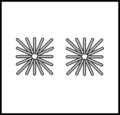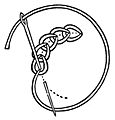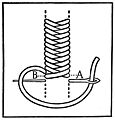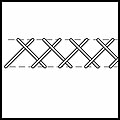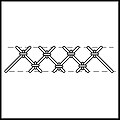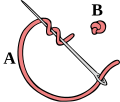Sewing/Printable version
| This is the print version of Sewing You won't see this message or any elements not part of the book's content when you print or preview this page. |
The current, editable version of this book is available in Wikibooks, the open-content textbooks collection, at
https://en.wikibooks.org/wiki/Sewing
Fabric

Terms
[edit | edit source]- Face
- the right side of the fabric
- Selvage
- finished edges
- Raw edge
- unfinished edges
- Grain
- the direction of the nap
- Nap
- Bias
- Warp
- Weft
- Bolt
Preparing Fabric
[edit | edit source]Always wash and press all fabric before sewing with it. New fabric will usually shrink a certain amount. Marking of patterns must be done on quite flat (well-pressed) fabric, as creases will distort the shape of the chalked pattern.
Types of Fabric
[edit | edit source]There are two groups of fabric, natural and synthetic. Synthetic fabrics are man made, while natural fabrics are either from a animal protein, like silk or wool, or a plant fiber, like cotton or linen. Fabrics can either be knit, or woven.
Natural fibers
[edit | edit source]Natural fibers are known to be more expensive than synthetic, but can drape beautifully and keep one cool in a way that synthetic fabrics often cannot.
Cotton Muslin
[edit | edit source]It is recommended that beginner in sewing get started with a cheap natural fiber such as cotton muslin. This is un-dyed unbleached cotton that is useful for making mock-ups and undergarments. It is a woven fabric so it has little stretch.
Cotton Jersey
[edit | edit source]Cotton jersey is a knit fabric. It is stretchy, soft, and does not wrinkle or pucker. It is another good beginner fabric, however it can be pricy. Its often used for activewear.
Cotton Flannel
[edit | edit source]Cotton Flannel is a warm, soft, medium weight fabric. Its weave is loosely spun. It's good for cold weather clothing.
Linen
[edit | edit source]A type of woven fabric made out of the flax plant. Very good for keeping cool in summer.
Wool
[edit | edit source]Wool is a protein fabric made from the hair/fleece of camels, goats, alpacas and other animals. It's very good for cold weather.
Hand sewing
For big projects such as sheets or clothing, sewing the fabric is done with a sewing machine, but for smaller/more precise projects, and parts that go on bigger projects, hand sewing is more practical, and finer details can be done. Examples of situations where hand sewing is a better option is for mending and closing seams, and doing decorative stitches, and when using very thin or thick fabric that a sewing machine needle can't go through.
Common utensils for hand sewing:
- Needles
- Pins
- Sewing thread
- Thimbles
- Thread scissors
- Measuring tape
Additional utensils
- Thread ripper
- Needle threading tool
- Scissors
- Pincushion/ Box for pins (for holding pins and needles)
- Chalk/Pencil (for marking up fabric, usually washes off with water)
- Embroidery thread
A new hand sewing project begins by the maker deciding what they want to make, using the materials they have. Common items sewn by hand are small bags, coasters, and decorative bows.
Patterns are commonly used in hand sewing. Patterns are like a 2D net that when sewn together at the right places, turn 3D and can be used. Patterns have markings to show where to cut, where to sew, where to fold, and where to pin the fabric together. Patterns can be found online and some are free and others are paid. Be careful when buying the paid ones online because they could be scams. Patterns can be downloaded and printed onto paper, cut out and placed onto fabric, and traced. Now you have the pattern on fabric.
Sewing utensils
Sewing Tools
[edit | edit source]Sewing needle
[edit | edit source]A sewing needle is essential for all sewing. There are many types of sewing needle, they vary depending on the project. Thicker needles are used for tough materials such as denim and leather, thinner for more delicate materials such as silk. Miller needles are a types of needle we're the eye as the same thickness as the rest of the needle and are useful for embroidery. For most sewing needles however the eye is slightly thicker than the shaft of the needle to make it easier to thread.
Thimble
[edit | edit source]Thimbles are a tool used for hand sewing. They are unnecessary if using a sewing machine. Thimbles worn on the middle of forefinger to protect the finger as it pushes the needle through fabric. They can be made of metal or leather. Some sewers use thimbles for all projects, while others avoid them unless absolutely necessary. They are most useful when dealing with thick fabric that is difficult to sew through.
Pins
[edit | edit source]Pins hold fabric in place while it is being sewn. They also are used in fitting garments.
Seams
The Longstitch: The first thing to be learnt, after the washing and pressing of fabric, is the basic hand-wrought longstitch. This is a simple, fairly easy, and very strong stitch that is used primarily for seams. Its form is basically a series of loops of thread through two or more layers of fabric, each overlapping the previous by half its length.
To learn to sew a neat, straight, longstitch, procure some cheap cotton or other natural-fibre fabric, some thread of the same stuff, and a medium sharp needle.
Seams are a way of joining bits of fabric together with stitches. There are a variety of seams they have different uses.
Plain
[edit | edit source]A plain seam is the simplest method.
To create a plain seam lay the pieces of fabric with their right sides facing each other At the edge you want to join sew a line of stitches through both pieces of fabric.
Flat-fell
[edit | edit source]Encloses the raw edges to prevent fraying.
Start off with a plain seam. Cut one of the seam allowances shorter. Tuck the longer allowance under the shorter on and stitch through all layers to hold in place.
The seam may be secured with either a whipstitch or a running stitch.
Lapped
[edit | edit source]
Embroidery
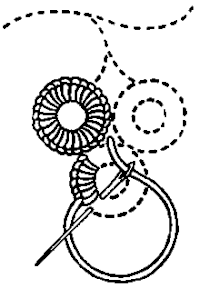
Embroidery is the art or handicraft of decorating fabric or other materials with needle and thread. Embroidery may also incorporate other materials such as metal strips, pearls, beads, quills, and sequins.
The basic stitches used in embroidery are chain stitch, buttonhole or blanket stitch, running stitch, satin stitch, and cross stitch. These stitches have been used since ancient times and are still the foundation of hand embroidery today.
Machine embroidery imitates hand embroidery, especially in the use of chain stitches, but the "satin stitch" and hemming stitches of machine work rely on the use of multiple threads and resemble hand work in their appearance, not their construction.
Stitches
[edit | edit source]Embroidery stitches are the smallest units in embroidery. Embroidery patterns are formed by doing many embroidery stitches, either all the same or different ones, either following a counting chart on paper, following a design painted on the fabric or even working freehand.
Embroidery uses various combinations of stitches. Each embroidery stitch has a special name to help identify it. These names vary from country to country and region to region. Some embroidery books will include name variations. Taken by themselves the stitches are mostly simple to execute, however when put together the results can be extremely complex.
Straight stitches
[edit | edit source]Straight stitches pass through the fabric ground in a simple up and down motion, and for the most part moving in a single direction.

Examples of straight stitches are:
- Running or basting stitch
- Simple satin stitch
- Algerian eye stitch
- Fern stitch
-
Arrowhead stitch
-
Eye stitch
-
Algerian eye stitch
-
Fishbone stitch
-
Open fishbone stitch
-
Raised fishbone stitch
-
Flat stitch
Some straight stitches have two journeys (generally forwards and backwards over the same path). These include:
- Holbein stitch, also known as the double running stitch
- Bosnian stitch
Back stitches
[edit | edit source]Back stitches pass through the fabric ground in an encircling motion. The needle in the simplest backstitch comes up from the back of the fabric, makes a stitch to the right going back to the back of the fabric, then passes behind the first stitch and comes up to the front of the fabric to the left of the first stitch. The needle then goes back to the back of the fabric through the same hole the stitch first came up from. The needle then repeats the movement to the left of the stitches and continues.

Some examples of a back stitch are:
- Stem stitch or outline stitch
- Split stitch. The needle pierces the thread as it come back up.
- Crewel stitch
-
Basic backstitch
-
Stem stitch
-
Whipped stem stitch
-
Split stitch
-
Threaded backstitch
-
Pekinese stitch
Chain stitches
[edit | edit source]Chain stitches catch a loop of the thread on the surface of the fabric. In the simplest of the looped stitches, the chain stitch, the needle comes up from the back of the fabric and then the needle goes back into the same hole it came out of, pulling the loop of thread almost completely through to the back; but before the loop disappears, the needle come back up (a certain distance from the beginning stitch -the distance deciding the length of the stitch), passes through the loop and prevents it from being pulled completely to the back of the fabric. The needle then passes back to the back of the fabric through the second hole and begins the stitch again. Examples of chain stitches are:
- Chain stitch
- Lazy Daisy stitch, or detached chain. The loop stitch is held to the fabric at the wide end by a tiny tacking stitch.
- Spanish Chain or Zig-zag Chain
-
Basic chain stitch
-
Braid stitch
-
Cable chain stitch
-
Knotted chain stitch
-
Open chain stitch
-
Petal chain stitch
-
Rosette chain stitch
-
Rosette chain line
-
Singalese chain stitch
-
Twisted chain stitch
-
Wheat-ear stitch
-
Zig-zag chain stitch
Buttonhole stitches
[edit | edit source]Buttonhole or blanket stitches also catch a loop of the thread on the surface of the fabric but the principle difference is that the needle does not return to the original hole to pass back to the back of the fabric. In the classic buttonhole stitch the needle is returned to the back of the fabric at a right angle to the original start of the thread. The finished stitch in some ways resembles a letter "L" depending on the spacing of the stitches. For buttonholes the stitches are tightly packed together and for blanket edges they are more spaced out. The properties of this stitch make it ideal for preventing raveling of woven fabric. This stitch is also the basis for many forms of needle lace. Examples of Buttonhole or Blanket Stitches.
- Blanket stitch
- Buttonhole stitch
- Closed Buttonhole stitch, the tops of the stitch touch to form triangles
- Crossed Buttonhole stitch, the tops of the stitch cross
- Buttonhole stitches combined with knots:
- Top Knotted Buttonhole stitch
- German Knotted Buttonhole stitch
- Tailor's Buttonhole stitch
-
Detached buttonhole stitch
-
Tailor's buttonhole stitch
-
Buttonhole stitch variations
-
Buttonhole shading
Feather stitches
[edit | edit source]Feather or fly stitches also catch a loop of thread on the surface of the fabric but they differ from buttonhole stitches in that the catching of the loop is not at right angles or it alternates from side to side. The result is a very naturalistic looking stitch that is often used to make leaves and branches. Examples of fly stitches are:
- Fly stitch, or Y stitch
- Feather stitch
- Faggoting stitch, or Straight Open Cretan
- Cretan Stitch
-
Featherstitch
-
Featherstitch
-
Featherstitch as a couching stitch, left, and long-armed featherstitch, right
-
Double featherstitch
-
Chained featherstitch
Cross stitches
[edit | edit source]Cross stitches or cross-stitch have come to represent an entire industry of pattern production and material supply for the craft person. The stitch is done by creating a line of diagonal stitches going in one direction, usually using the warp and weft of the fabric as a guide, then on the return journey crossing the diagonal in the other direction, creating an "x". Also included in this class of stitches are:
- Herringbone stitches, including the hem stitch
- Breton stitch, here the threads of the "x" are twisted together
- Sprat's Head stitch
- Crow's Foot stitch, these last two stitches are often used in tailoring to strengthen a garment at a point of strain such as a pocket corner or the top of a kick pleat.
-
Basic cross stitch as worked in embroidery
-
Long-armed cross stitch
-
Double cross stitch
-
Italian cross stitch
-
Basket stitch
-
Leaf stitch
-
Herringbone stitch
-
Tacked herringbone stitch
-
Tied herringbone stitch
-
Montenegrin stitch
-
Thorn stitch
-
Trellis stitch
-
Van Dyke stitch
Knotted stitches
[edit | edit source]Knotted stitches are formed by wrapping the thread around the needle, once or several times, before passing it back to the back of the fabric ground. This is a predominate stitch in Brazilian embroidery, used to create flowers. Another form of embroidery that uses knots is Candlewicking, where the knots are created by forming a figure 8 around the needle. Examples of knotted stitches are:
- French knot, or twisted knot stitch
- Chinese knot, which varies from the French knot in that it takes a tiny stitch in the background fabric while creating the knot
- Bullion knots
- Coral stitch
- Four-legged knot stitch
- Turk's head knot
There are also more complex knotted stitches such as:
- Double-knot stitch
- Knotted Loop stitch
- Plaited Braid stitch
- Sorbello stitch
- Diamond stitch
Knotted edgings based on buttonhole stitches include:
- Antwerp edging stitch
- Armenian edging stitch
-
French knot
-
Coral stitch
-
French knots
-
Bullion knot
-
Bullion knots
-
Four-legged knot stitch
-
Turk's head knot
-
Double-knot stitch
-
Plaited braid stitch
-
Antwerp edging
-
Armenian edging
Couching and laid work
[edit | edit source]Couching or laid stitches involve two sets of threads, the set that is being 'laid' onto the surface of the fabric and the set which attach the laid threads. The laid threads may be heavier than the attaching thread, or they may be of a nature that does not allow them to be worked like a regular embroidery thread, such as metal threads. The stitches used to attach the laid thread may be of any nature; cross stitch, buttonhole stitch, straight stitch; but some have specific names:
- Pendant couching
- Bokhara couching
- Square laid work
- Oriental couching
- Battlement couching
- Klosterstitch
- Roumanian couching
-
Couching
-
Couched filling
-
Laid work
-
Bokhara couching
-
Roumanian stitch
-
Roumanian couching
-
Underside couching, front (left) and back (right)
Technique
[edit | edit source]Basically, there are two ways to do embroidery efficiently and orderly. What works better depends on the stitches and materials used, and on personal preference.
Hand-sewing method
[edit | edit source]The needle is brought to the upside of the fabric. For doing the stitch properly, it is inserted into the fabric and brought back to the surface in one movement. Then the thread is pulled through. The same method is used for plain hand sewing.
A thimble is usually used on the middle finger to avoid minor injury. Once the needle is inserted into the fabric, the hooded middle finger is used to push it through; the thumb and index finger grab the needle at the front as soon as possible and pull at the same time. This can speed up working when the embroiderer is used to it.
This method can be done using an embroidery frame or free-hand, but usually an embroidery frame or hoop is used to make work easier. The technique uses frames that allow for adjustment of fabric tension, as the fabric can't be too strongly stretched. in order to allow inserting the needle without pulling the fabric too much.
Stab method or Maggam work
[edit | edit source]This method is popular in India.
The needle is inserted into the fabric at a 90 degree angle, then the thread is pulled through. Then, the needle is again inserted, this time from the underside to the surface; again, the thread is pulled through.
A thimble is not usually required to avoid injury with this method, but is sometimes used to make pushing the needle through easier.
A frame or hoop is used. A mounted hoop or frame makes the work faster, such that both hands are free for the embroidery. The dominant hand is held under the fabric, the non-dominant hand above it, and the needle is handled by each respective hand without necessity for hand position changes.


